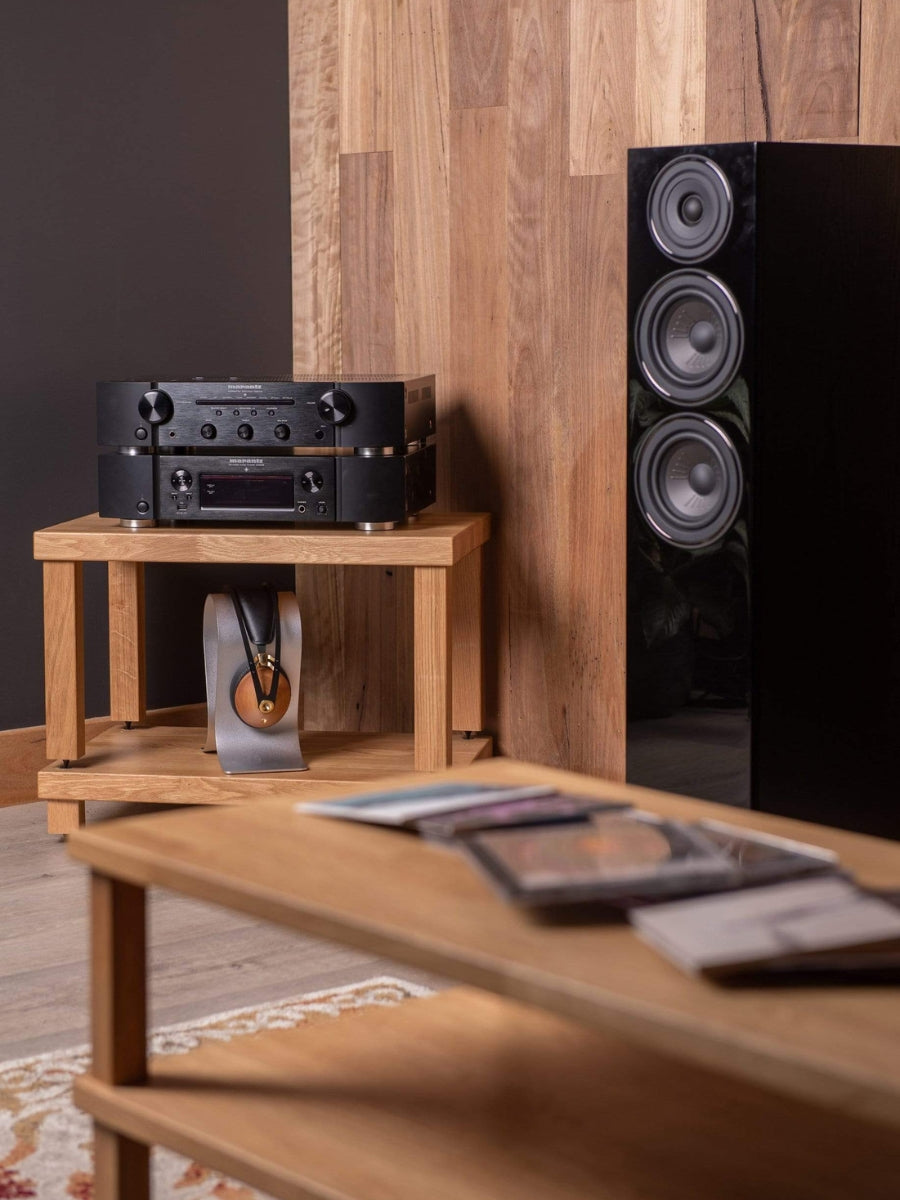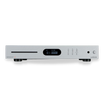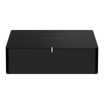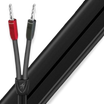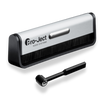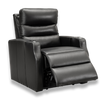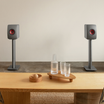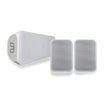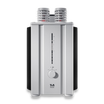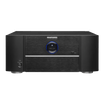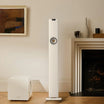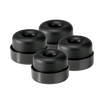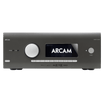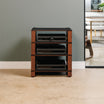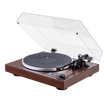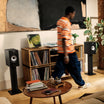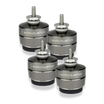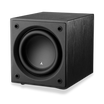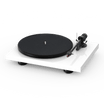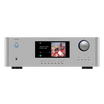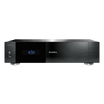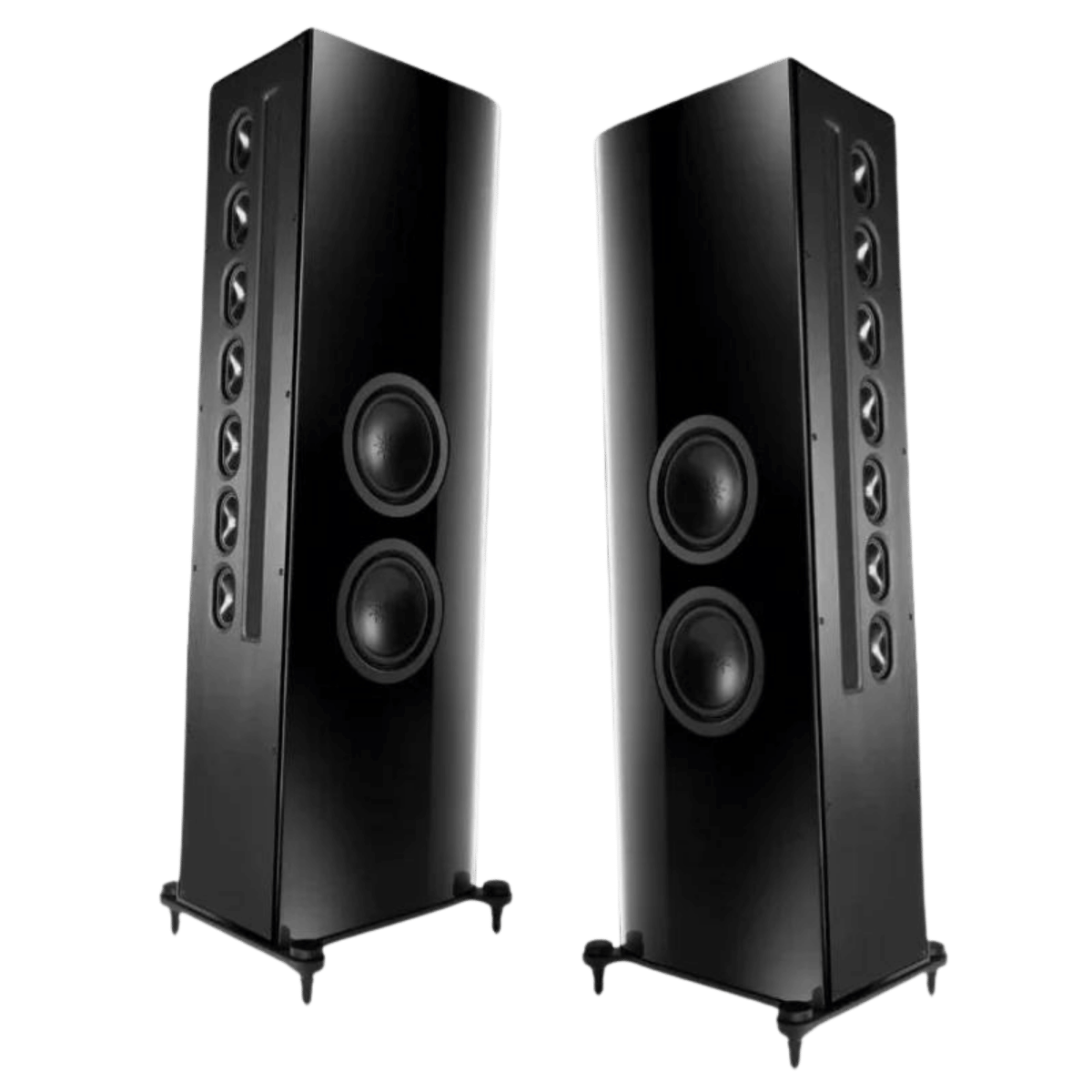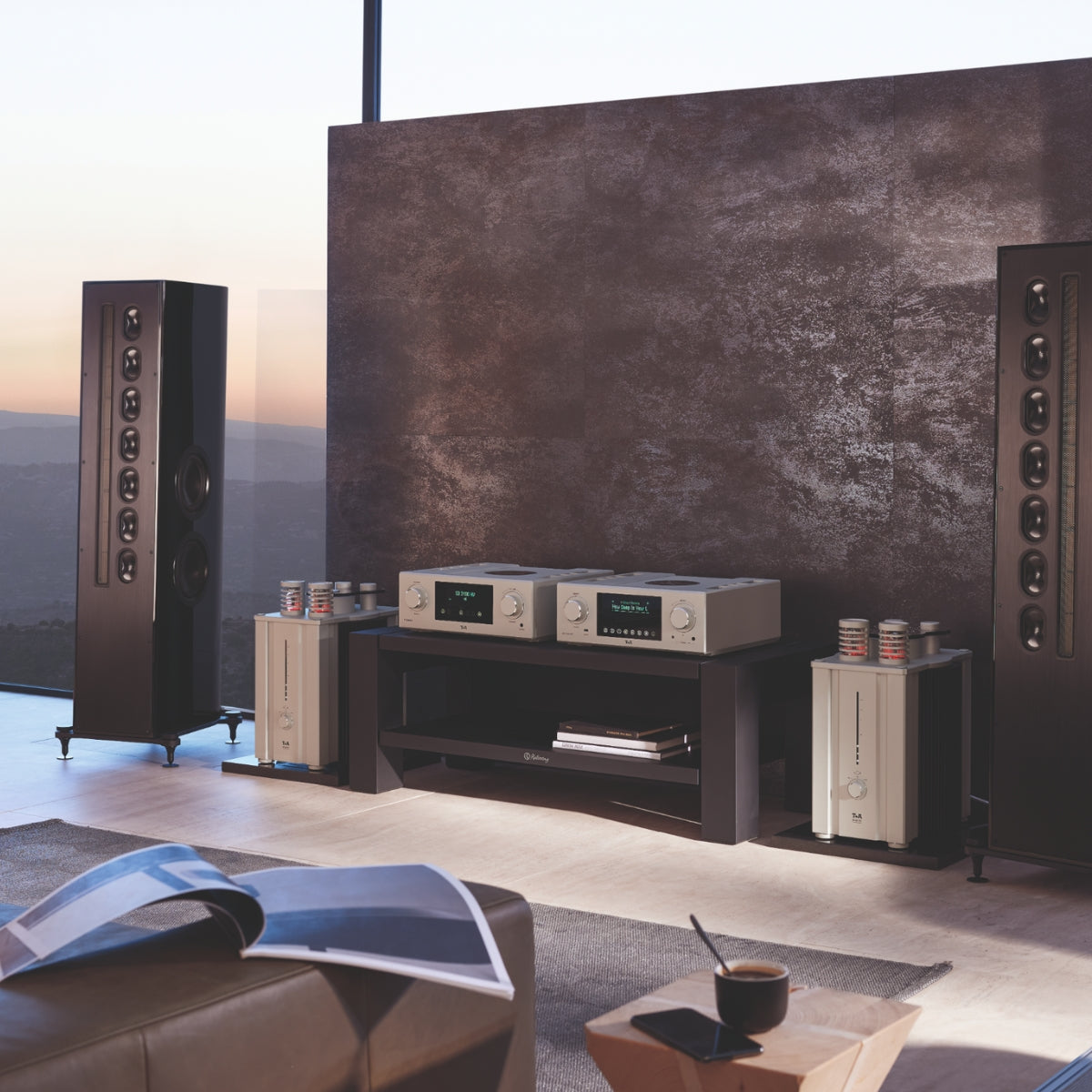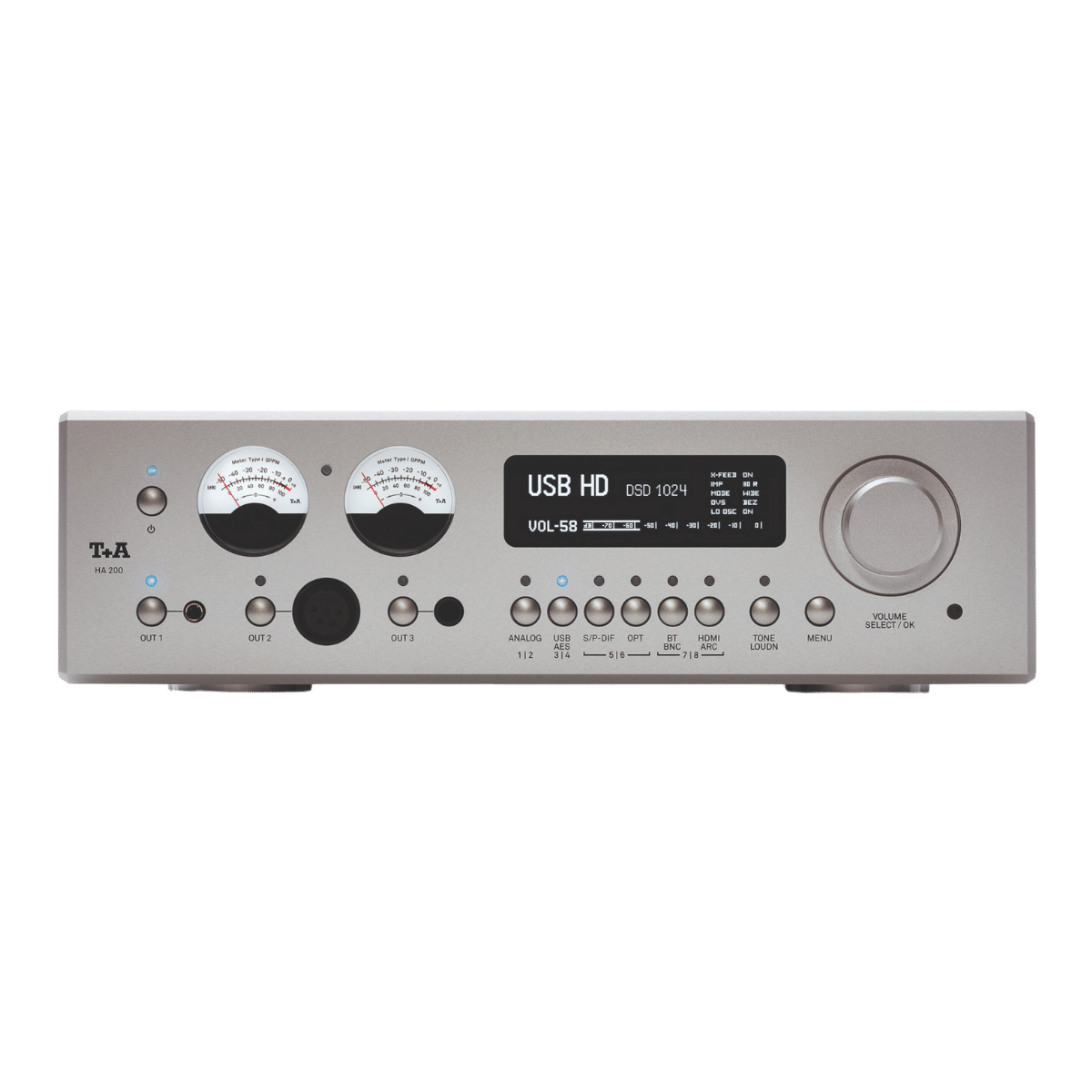

T+A Hi-Fi Solitaire Series
Filters
7 products
TELL ME MORE ABOUT
T+A Hi-Fi Solitaire Series
It is not a coincidence that our headphones bear the name Solitaire. Back in 1983 our founder developed T+A’s first planar-electrostatic transducer: the mid-high range unit for the Solitaire... Read More
It is not a coincidence that our headphones bear the name Solitaire. Back in 1983 our founder developed T+A’s first planar-electrostatic transducer: the mid-high range unit for the Solitaire OEC active loudspeaker, which remains a legend to this day. Since that time we have continued to exploit this principle for our High-End speakers. The current Solitaire CWT range employs a planar-electrostatic mid-range / treble unit whose frequency range extends up to and beyond 50,000 Hz, and which is capable of generating sound pressure levels above 120 dB. The diaphragm of these transducers consists of a special ultra-thin film, driven by a powerful electrical field.
This principle was the obvious choice for our first headphones, based on the exceptional qualities of this type of planar transducer and our thirty-five years of experience in the development and manufacture of film transducers. Planar-magnetic transducers are very similar to electrostatic devices, as their diaphragm also consists of a thin film driven by a strong magnetic field. For that reason it was therefore natural to start our headphone division by developing open planar systems for our first headphone series, and build them here in Herford. The fundamental designs of planar magnetic systems are ideally suited to High-End headphones, and are inherently superior to dynamic alternatives.
Our flagship model bears the name of the Series: The Solitaire P was introduced in March 2020 and quickly became a references level headphone, cherished by critics and customers alike. The Solitaire P-SE brings the spirit of the Solitaire P to a new and exciting price point.

Headphone Design Philosophy
In every transducer – regardless of whether a loudspeaker or headphones – the diaphragm needs to be driven as evenly as possible. To a limited extent dynamic systems based on voice coils are partially successful in this, but planar systems – such as electrostatic or magnetostatic devices – are much more effective in this regard, since the driving force in both these processes is distributed over the whole of the diaphragm, rather than being localised at the coil position. In principle the actual transducer of our magnetostat consists of rod-shaped high-performance neodymium magnets of varying length, with an innovative pole geometry. These magnets are held in a precise, accurately manufactured mount which guarantees the positioning of the magnetic poles to an accuracy of a few hundredths of a millimetre. This design generates a totally linear magnetic field, in which the special ultra-lightweight diaphragm moves. The diaphragm itself is only a few µm thick, and consists of a structurally stable High-Tech polymer material; it also bears an array of very light conductors – also only µm thick – which are applied in a sophisticated, highly precise photo-chemical process. This unique technology ensures that the entire surface of the diaphragm is driven absolutely evenly, thereby eliminating the partial oscillations which are unavoidable with localised drive systems. The net result is a series of transducers with an enormously wide dynamic range, high peak sound pressures and extremely impressive linearity and freedom from distortion.
Our Solitaire P and Solitaire P-SE headphones are driven by our in house transducers TPM 3100 and TPM 2500, respectively. Both of which are manufactured in Herford, Germany.

Headphone Amplifiers
It 2020 will be remembered as the year in which we introduced a whole new family of products: headphones. We develop a range of extremely innovative headphones and headphone amplifiers, evincing the same consistently systematic approach and commitment which we have always adopted in the development of our audio systems and loudspeakers. Our first model of headphone amplifier is the HA 200, and it benefits from our extensive expertise and several decades of experience in the development and manufacture of amplifiers and transducers. We have not been content simply to adopt existing technologies, preferring instead to develop and optimise them for the particular requirements of headphones. The result is a device the like of which has never before existed, but it is far more than that: it sets completely new standards in respect of sound quality, performance, connection facilities and appearance. In fact, the HA 200 encompasses the combined requirements of professional users active in studio technology and those of audiophile music lovers, who wish to run multiple headphones from a single device. This principle was the obvious choice for our first headphones, based on the exceptional qualities of this type of planar transducer and our thirty-five years of experience in the development and manufacture of film transducers. Planar-magnetic transducers are very similar to electrostatic devices, as their diaphragm also consists of a thin film driven by a strong magnetic field. For that reason it was therefore natural to develop an open planar system for our first headphones, and build them here in Herford. The decision to start by developing a planar-magnetostat, and only then an electrostatic device, was based on the realisation that a magnetostat has a wider field of application, since it does not require a power supply voltage – as is the case with an electrostatic device. Both fundamental designs are ideally suited to High-End headphones, and are inherently superior to dynamic alternatives.
We insist that our headphone amplifiers should be capable of optimum sound quality, and for this reason we are developing them in a focussed manner, matching either dynamic and magnetostatic or electrostatic headphones. This decision obliges us to consider the completely different requirements regarding the output stages. The HA 200 is conceived to handle dynamic and magnetostatic headphones, and its entire circuit topology and technology are designed to fulfil the special requirements of these types of transducer. This is the only means of obtaining truly unique results in terms of sound quality. Compared with loudspeakers, the impedance bandwidth of headphones is substantially wider, and this presents a genuine challenge to the amplifier design. Low-impedance types require high currents, whereas high-impedance alternatives draw low currents, but require an extremely stable voltage.

Headphone Amplifier Design Philosophy
This in turn means that the output stage must be capable of delivering relatively high currents, while the transformer and the mains section must be extremely stable and constant. Our amplifier has also been fitted with a circuit, which makes different output impedances freely selectable for each of the three outputs (6.3 mm jack, 4.4 mm Pentaconn, XLR-4 pin), so that the headphones can be optimally adapted to the individual sound ideas.
The last few years have brought a very significant change in the field of application of headphone amplifiers. In the past they were usually connected to the analogue output of a stereo system, utilising the system’s sources, but nowadays we frequently find a preference for dedicated stand-alone devices. That is why we have not only furnished our headphone amplifier with very high-quality analogue inputs, but also installed digital inputs and converters of the highest quality, which make it possible to exploit a vast range of digital sources whilst maintaining very high standards of quality. The analogue and digital sections are completely galvanically isolated, and each features its own mains power supply. Our aim was to build a headphone amplifier which completely satisfied our very high requirements in terms of sound quality. The outcome of our efforts is a true thoroughbred: an exceptional device which eschews integral digital sources completely, thereby eliminating even the tiniest of adverse influences in the analogue section of the amplifier.
The HA 200 offers a wide range of high-quality connection facilities on the input and output side, making the amplifier a superb choice for music-enthusiasts and professionals alike.

NEED MORE GUIDANCE?
We are here to help
Check out some of our most commonly asked questions.
What do I need to play records?
Getting into vinyl? That’s awesome! We have some curated turntable Hi-Fi packs, with everything you'll need to get spinning right away. But if you want to build your own, read on for all the details.
First off, you'll need a turntable. It's the star of the show, so make sure it’s in good nick, with a decent cartridge and stylus (needle).
Next, there’s the phono preamp. Some turntables or amplifiers come with one built-in, but if yours doesn’t, you’ll need one as a bridge between your turntable and amplifier or powered speakers.
For the sound output, you’ve got two options. You can go with a traditional setup involving an integrated amplifier to take the signal from your phono preamp and power your passive speakers. Alternatively, you can opt for powered speakers, which have the amplifier built in – a handy all-in-one solution.
Speaking of speakers, good ones are a must for that rich, warm vinyl sound we all love. Whether you go for bookshelf or floorstanding speakers (or powered ones) depends on your space and budget.
And there you go! With these essentials, you’ll be ready to dive into your vinyl collection and enjoy that classic sound.
What can a wireless speaker do?
Wireless speakers are a game-changer for how you enjoy music and audio around the house. First off, they let you stream music wirelessly from your phone, tablet, or computer, so no more messing about with cables. You can easily play tunes from Spotify, Apple Music, Tidal or whatever streaming service you fancy.
If you’re into having music everywhere, many wireless speakers offer multi-room audio. You can sync them up to play the same music in every room or control what plays in each room individually, perfect for parties or just keeping the vibes consistent throughout your home.
Voice control is another brilliant feature. Many come with built-in assistants like Alexa, Google Assistant, or Siri. You can control your music with just your voice, ask for the weather, set reminders, or even control other smart home devices.
Sound quality? These little gadgets often pack a punch, delivering high-quality audio that can rival traditional wired setups. Some even offer 360-degree sound, filling the room with music from every angle.
In a nutshell, wireless speakers bring flexibility, convenience, and top-notch sound to your audio experience, making them a fantastic addition to any home. Whether you’re hosting a party, working from home, or just chilling out, they make listening to music a breeze.
How do you choose the right speaker & amplifier combination?
Deciding on a good speaker and amplifier combination is like putting together a perfect wine and cheese pairing—it’s all about balance and harmony. Here’s a conversational guide to help you through it:
First, consider your speakers. These are your main players, so you want to choose ones that fit your space and listening preferences. If you love deep bass and have a bit of room, floorstanding speakers might be your go-to. For smaller spaces or a more subtle look, bookshelf speakers are fantastic.
Now, onto the amplifier. This is where things get interesting. Your amp needs to match your speakers in terms of power and impedance. Check the wattage ratings on your speakers—your amplifier should provide enough power to drive them properly. Too little power and you’ll be missing out on sound quality; too much, and you risk damaging your speakers.
Next, think about the impedance (measured in ohms). Your amp and speakers should be compatible here too. Most speakers are rated at 8 ohms, but some can be 4 or 6. Make sure your amplifier can handle the impedance of your speakers to avoid any performance issues.
Another important factor is the type of sound you’re after. Some amps are known for their warm, rich tones, while others might be more neutral or even slightly bright. It’s a bit like choosing between a vinyl record and a digital stream or CD —each has its own charm. If possible, listen to different amp and speaker combinations to see what sounds best to your ears.
If purchasing online, note that at LE, we have made recommendations on speaker & amplifier combinations that we think sound wonderful together within each product listing.
Don’t forget about connectivity and features. Modern amplifiers often come with a host of options like Bluetooth, Wi-Fi streaming, and various inputs for all your devices. Make sure your amp has the inputs you need for your turntable, CD player, or streaming device.
Finally, consider your budget. Great sound doesn’t always mean breaking the bank, but be prepared to invest to get a quality setup that will last.
In the end, trust your ears. Listen to a few combinations if you can, and go with what makes your music sound the best to you.
Why do I need a headphone amplifier?
If you’re diving into the world of high-quality audio, a headphone amplifier can be a real game-changer. Think of it like this: most standard devices, like your smartphone or laptop, just don’t have the oomph needed to drive headphones properly. They might get the job done, but they won’t do your music justice. A headphone amp gives your headphones the power they need, ensuring you get the volume and clarity that really makes your music shine.
It’s not just about making things louder, either. A good headphone amp can significantly improve sound quality. You’ll get clearer highs, richer mids, and tighter bass, making your favourite tracks sound even better. You might notice details you’ve never heard before, especially if you’re listening to high-resolution audio files.
Premium headphones often have higher impedance, meaning they require more power than your typical audio source can provide. A headphone amp can handle this with ease, making sure your headphones perform at their absolute best. Plus, many amps come with extra features like bass boost, equalisation, and gain control, giving you more ways to tweak the sound to your liking.
In short, if you’re passionate about your music and want to hear it in the best possible way, a headphone amplifier is definitely worth considering. It’s all about unlocking the full potential of your gear and really getting the most out of your listening experience.
Where should I start when designing a home cinema?
Designing your own home cinema? That's awesome! We are here to help walk you through the process, but as a starting point, here’s what we would recommend and where to kick things off:
First up, pick your spot. For most people this is your existing lounge room, but if you have an underused garage, or spare bedroom, then you have an opportunity to create your very own true Home Cinema experience. Find a room that’s just right—not too cramped and ideally away from noisy areas. This sets the stage for that immersive movie experience.
Next, think about how you’ll set things up. Plan where your seats will go and where to place your projector screen for the best view from every angle. It’s all about creating that comfy, cinematic vibe.
Sound matters, too. Consider if you want a wireless system for simplicity or a full surround sound speaker system with AV receiver for that surround-sound thrill. Think about soundproofing or adding acoustic panels or thick carpets to really amp up the audio quality of the room.
Now, onto the screen. Decide between a crisp TV or a projector setup, depending on your room size and personal style. Maybe even throw in some dimmable lights or smart lighting to set the mood just right.
And hey, don’t forget comfort. Invest in plush cinema seating and think about the décor—whether it’s movie posters, blackout curtains, or popcorn machine & bar area, whatever gives you that true cinema feel.
Lastly, tech it up! Make sure everything—from your Blu-Ray player & Apple TV to your gaming consoles—is set to sync perfectly with your new setup.
With these steps, you’re on your way to creating a home cinema that’s not just a space, but an experience. Enjoy movie nights like never before!


